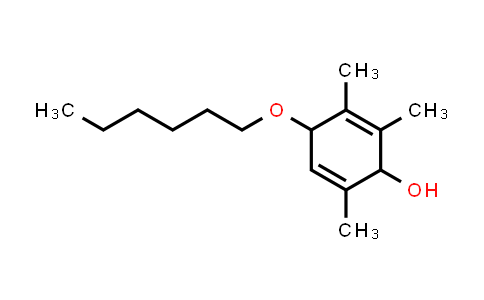| Chemical Name |
HTHQ |
| CAS Number |
148081-72-5 |
| MDL Number |
MFCD00797612 |
| Molecular Formula |
C15H26O2 |
| Molecular Weight |
238.37 |
| Synonyms |
1-O-hexyl-2,3,5-trimethylhydroquinone |
Introduction of 148081-72-5 :
HTHQ (1-O-hexyl-2,3,5-trimethylhydroquinone) is a potent lipophilic phenolic antioxidant. HTHQ has considerable anti-oxidative activity by directly reacting with reactive oxygen species (ROS) and scavenging ROS to form more stable free radicals[1][2]. IC50 & Target: ROS[1] In Vitro: HTHQ (0-100 μM; 24 hours; PC12 cells) treatment increases cell viabilities in a dose-dependent manner[1].
HTHQ (10 μM; 0.6-24 hours; PC12 cells) inhibits 3,4-L-Dihydroxyphenylalanine (L-DOPA) -induced phosphorylation of sustaines extracellular signal-regulated kinases (ERK1/2), p38 mitogen-activated protein kinase (MAPK), and c-Jun N-terminal kinase (JNK1/2). HTHQ also normalizes L-DOPA-reduced Bcl-2-associated death protein (Bad) phosphorylation and Bcl-2-associated X protein (Bax) expression, promoting cell survival[1]. In Vivo: HTHQ (50-200 mg/kg; oral administration; for 4 weeks; specific pathogen-free male Sprague Dawley rats) treatment significantly improves liver weight and serum chemistry level. HTHQ reduces hydroxyproline and malondialdehyde level in the liver. HTHQ treatment also reduces fibrotic septa. HTHQ administration shows reduced mRNA level of PDGF (Plateletderived growth factor) , α-SMA (α-smooth muscle actin) and TGF-β (transforming growth factor-β) than DMN-induced hepetic fibrosis animals in the liver tissue[2].
| Purity |
NLT 98% |
| Storage |
at 20ºC 2 years |
*The above information is for reference only.
